In its waning years, what Studebaker didn’t have in terms of resources, it made up for in spirit. The company kept trying “new” things, like the Hawks in the 1950s and the Avanti in the 1960s. They also introduced a station wagon with a sliding roof called the Wagonaire. Like most Studebaker products, it sold modestly but stuck around from 1963 until car production ceased altogether in Canada in 1966. This 1964 Daytona Wagonaire is being offered by a dealer in West Chester, Pennsylvania. We don’t know if it’s a beautiful restoration or a superbly maintained original. Either way, it’s available here on eBay for $26,500 (or you can submit an offer). We appreciate the nifty tip from Russell Glantz!
The Studebaker Wagonaire’s roof design was the invention of industrial designer Brooks Stevens, who was charged with expanding the company’s limited model range on a shoestring budget compared to GM, Ford, and even Chrysler. Using a 1959 concept car as the inspiration, Stevens developed the Wagonaire by taking the standard Lark station wagon body and modifying it above the beltline. That led to the roof gaining a panel over the cargo bay that manually retracted into the forward section of the roof above the rear passenger’s seat. Now you could haul tall items like refrigerators or have the best seat in the house at the drive-in movies.
All was not rosy with the design. Early on, customers found that the roofs could leak water if the drainage tubes in the roof’s slider assembly weren’t kept clear. Studebaker went to work and redesigned the seals, but we understand the fix wasn’t foolproof. If the seller’s wagon ever experienced this problem, it certainly doesn’t show it now. For 1964, Studebaker managed to give its once-successful Lark compact a major facelift and scaled back the name to make it seem like a new car (hence the birth of the Daytona). But it was still a Lark under the skin. But when U.S. production ceased in December 1963, the Wagonaire made its way to Canada while the Avanti and Gran Turismo did not.
The selling dealer provides an army of photographs for this second-year Wagonaire which features a more streamlined body than the ‘63s. You’d be hard-pressed to find any flaws in the car in those photos and no mention of any is made. But it is a nearly 60-year-old automobile that isn’t likely to win any Concours awards but will certainly turn heads at Cars & Coffee.
As one of just 1,563 Daytona Wagonaires built in 1964, this one comes with Studebaker’s 289 cubic inch V8 that produced 240 hp with a 4-barrel carburetor. This would be the last year for Studebaker supplying its own engines. After that, Chevrolet motors would be found under the hoods. This car also has a 3-speed manual transmission, but it does feature an overdrive. And it comes with the optional third seat, so eight passengers can ride in this vintage machine. I’ve always had a soft spot for underdogs like Studebaker and this one certainly tempts me. A lot.
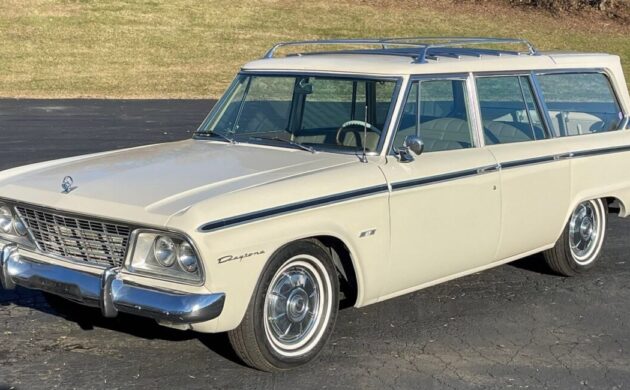
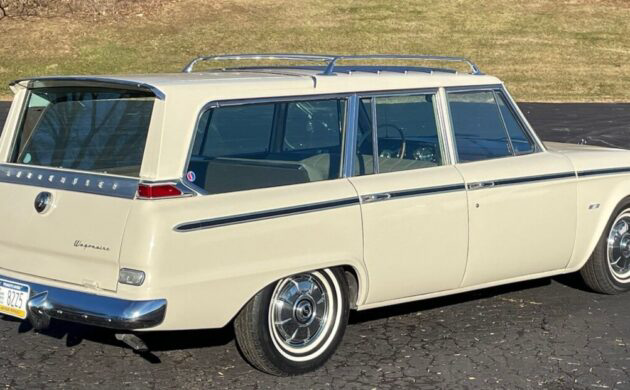
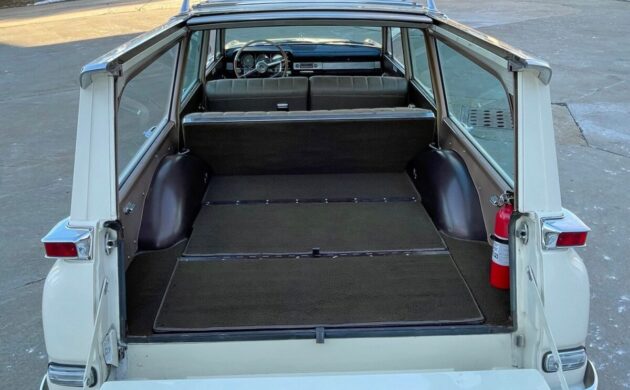
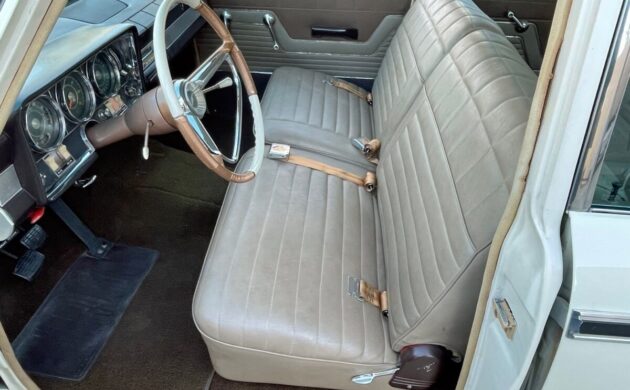
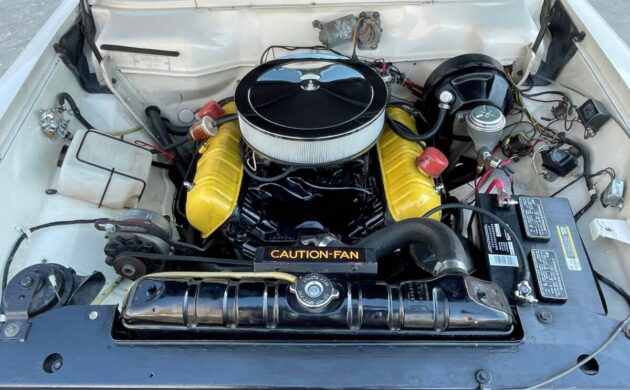


I don’t think this is an original car, I’m guessing this beautiful wagon has been restored. It’s a very good restoration but there is evidence of wear from use; the driver’s side carpet, the gate step bar, the wheel covers and around the gauges. The engine compartment is perfect, it looks like the engine has never even been started. Everything there looks period correct except for the chrome air cleaner, that just looks out of place. This Stude is a real gem, and I can’t believe there are too many Wagonaires left, so I think the ask is fair. I doubt you could find a better one, if you could find one at all.
My favorite style of Studebaker.I’ve never seen a
Wagonaire in person,just pictures & the Matchbox one.
I still have the Matchbox version, complete with a horse trailer, had it since I was about nine years old.
me too! I still have about 100 Matchbox cars. Some still have the original box. price tags were 4/$1.00 and 3/88cents.
It’s been polished up really nice. Not a full restoration but a nice car. Knew a guy many years ago that had several of these believe it or not. Only one 64 the rest were 63’s but yep roof panels do leak. Can’t imagine standing a refrigerator up in there but yeah they were advertised for that. That fuel regulator says there is an electric fuel pump hidden somewhere. If your a Studebaker fan might be your car.
One whole gauge devoted to saying “Studebaker”!
They didn’t order the clock.
You really have to give Brooks Stevens some serious credit on this one. Working with an ancient platform, he created a car that looks more late 1960s early 1970s then of its time. Except for the tail lights, it looks so far ahead of any other 1964 car out there. Sure there were many more beautiful cars in 1964 but they were all “of their time” This car, with it;s tall greenhouse and recessed headlights was from the future. no one knew that at the time.
Yes, his updates to the Lark and Hawk were just brilliant. The final Studebakers looked completely up-to-the-minute and very handsome, despite being a decade old under the skin.
GMC Envoy XUB copied Studebaker’s sliding roof concept
https://www.hemmings.com/auction/2004-gmc-envoy-xuv-592090
Except the Studebaker was much better looking.
Wow!
What a stunner, look at ALL THAT ROOM.
Wish I knew more and that is where seller-quality is so important.
Too bad a dealer here.
Good sellers can share needed History, the mechanics that worked on it for future work/questions, yet to be done work, etc etc.
This is nice but I know next to zero about so much, this included.
This Wagon is way ahead of its time.
Hope it goes to a good Home!
Very nice car, and the V8 with a 3 speed and overdrive make it even more desirable.
Awesome looking car. It’s a crying shame that Studebaker was no longer going to be producing cars after 1965-66. My favourite Studebakers are the 1959-61 Lark, the 1960-64 Champ, and this, the 1964-66 Daytona.
The wagons were notorious leakers as someone has already pointed out.
A lot of things from that era are “notorious leakers”
I ran a shop that specialized in Studebakers, and I’ve owned both a ’63 and a ’64 sliding roof wagon. In the late 1970s I remember seeing a very rare red 1964 Daytona Wagonaire with the Avanti R-1 engine, 4-speed, factory tachometer and bucket seats, power steering & disc brakes, and air conditioning. Problem was, the car had been parked for years under some pine trees, and the sliding roof panels had leaked for years. This caused the entire bottom of the car to rust away because the floors filled up with water. A friend in the Studebaker club ended up with the car for parts.
These Wagonaires have short steel drain tubes in each forward corner of the sliding roof channels, and the tubes are connected to rubber drain tubes that run down thru the C posts. With age, these rubber tubes crack where they are pressed onto the steel tubes. Plus, some mechanics would try to unstop the drains with compressed air, and this often popped off the rubber tubes.
Installing new flexible tubes requires some disassembly of the headliner to gain access. Once that is open, it’s easy to install new drain tubes. On the few examples I repaired, I used a clear vinyl hose instead of the black rubber, gluing the hoses in place. I performed this repair on my ’63 about 1980, then sold it to a friend who still has it, so I know they are still open and not leaking.
One of the reasons they are still working and not clogged, was the advice I offered when he bought the car; Always park the car on level pavement, or even better, with the rear of the car pointing downhill. The more the rearward slope, the better.
Because [like a sliding steel sunroof] dust and dirt can build up in the channels, even with a Wagonaire in a dry climate, it’s important that the front of the car is pointed uphill when washed, or subject to an infrequent rainstorm, as you always want the dust/dirt flushed out the back rather than down the front tubes.
I know very little about these. Is it priced right?
Probably pretty close actually, given it’s condition and rarity.
i miss studebaker!
Well, that’s odd. I used all caps when posting this.
Yet one more daring move by Studebaker at the end. These are quite amazing cars, about the size of a later Mercedes, with far more passenger room and comfort than any other American offering near their size. It’s because they were descended from the 1953 Studebaker, which itself was not quite as wide or long as other full-size cars of its era. So with that structure, Studebaker could create a compact with nearly full-size room.
Studebaker really went back to the future with the Lark and the Wagonaire version. Our family owned a 1960 Lark wagon, V8, 3-speed, but unfortunately no overdrive. I remember Dad rejecting that option when the salesman suggested it. Big mistake on Dad’s part. Still, the Lark served us well for years.
Not only could you haul a fridge upright but we hauled a 15 foot plum tree that we dug up and transplanted from a friend of my father’s yard to our house about five miles away. Well it was five miles normally but due to all the viaducts in Chicago it was probably triple that b/c of the route we had to take so we cleared underneath those viaducts some scary moments…. Guess who had to ride in back with his sibling trying to keep it steady. Good thing we didn’t have seatbelt laws at that time.
I’m not Catholic (just your Lutheran cousin), but… here’s your stateside Pope mobile if the Pope ever shows up at a Notre Dame football game. Center end-zone beneath touchdown Jesus.
If the Pope can’t make it, I’m sure they can find a couple of Arizona cardinals to take it for a spin.
Good one!
This is the 225 HP engine not the 240 HP. The 240 HP engine had a different PCV system. It was available in this car as a option.
I owned a ’63 Wwagonnaire in 76-’77. 289, 3 speed with overdrive. 22 m.p.g. on the highway !
Brooks Stevens did an outstanding job updating the lowly Lark body panels for Studebaker’s last hurrah – the 1964-1964 model years. Bob Marchs did a mild refresh for 1966 but the sheet metal was kept intact. Harder to believe, this contemporary looking body sits on a 1953 designed undercarriage.
For now, I have a 1964 Daytona convertible. Would like to supplement it, or replace it with a 1966 Sport Coupe in the future. Wagons are great, but don’t carry the cachet of a coupe or convertible to most collectors.
I’ve never known if the sliding panel was operated electrically. Does someone know? I have only seen one in my lifetime. It was driving in Tulsa, Oklahoma on the freeway and the panel was open. Great look.
It was operated manually.
My driving lessons and first car was the family ’59 Studebaker Lark VIII wagon. 3 on the tree with the overdrive. Loved that car and had planned to keep it forever. (Could fit “half” the football team in it on our way to the Chuck Wagon for unlimited eats). BUT in ’71 my mother GAVE it to some hippy chick while I was at school. Still remember the license plate… black/yellow CA, DUY 648. Let me know if you know where it is today. Still miss it terribly.
The sliding roof was manually opened and closed. It could be locked in the open or closed position only. The window was operated by a hand crank on the tailgate or via an optional electric motor with a dash mounted switch.
Studebaker offered another unique feature on wagons with a third, rear facing seat; they could also be equipped with a fold out stair off the tailgate.
Neat features (gimmicks) intended to sell cars, not sure they helped much in the final analysis.